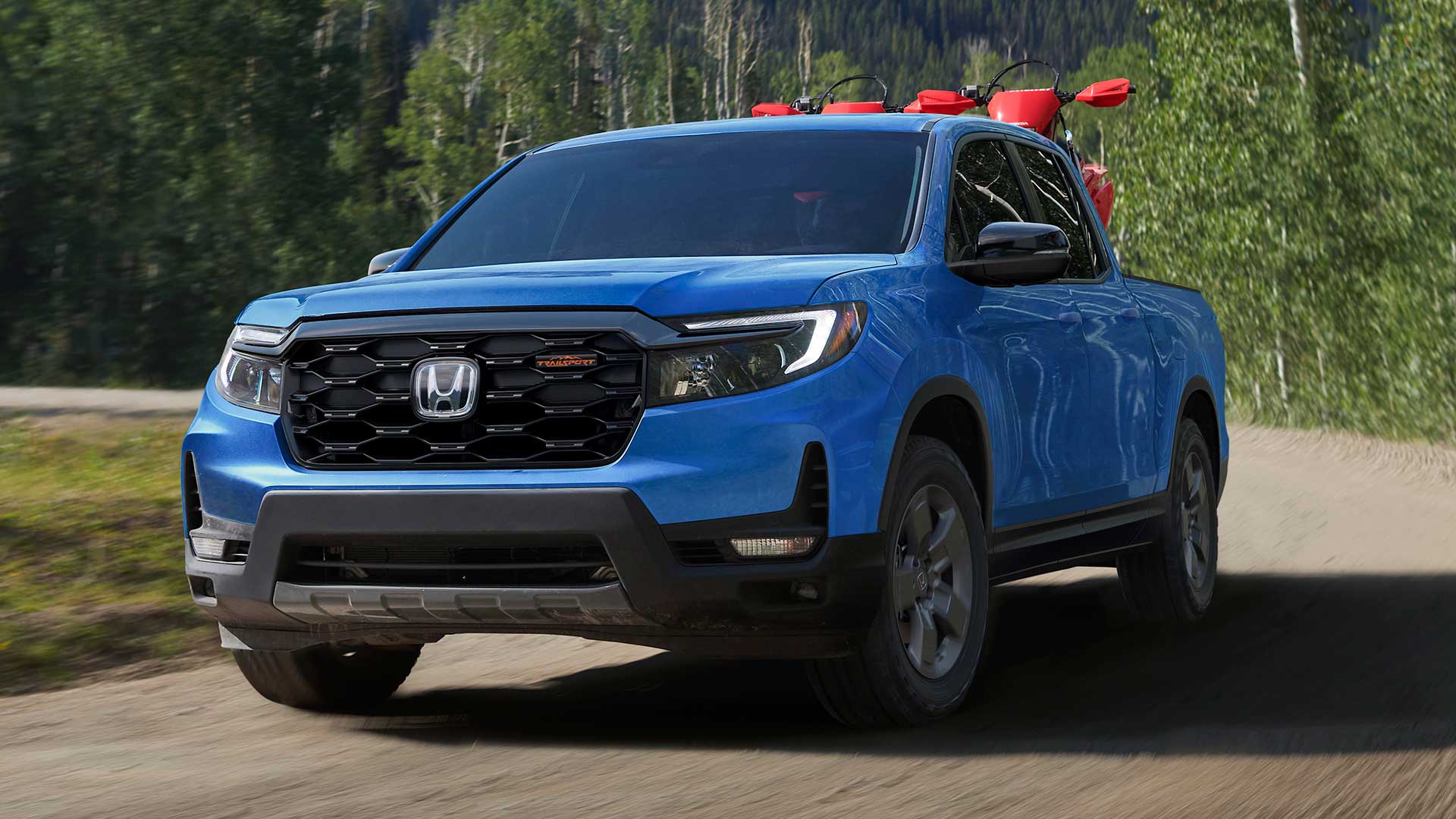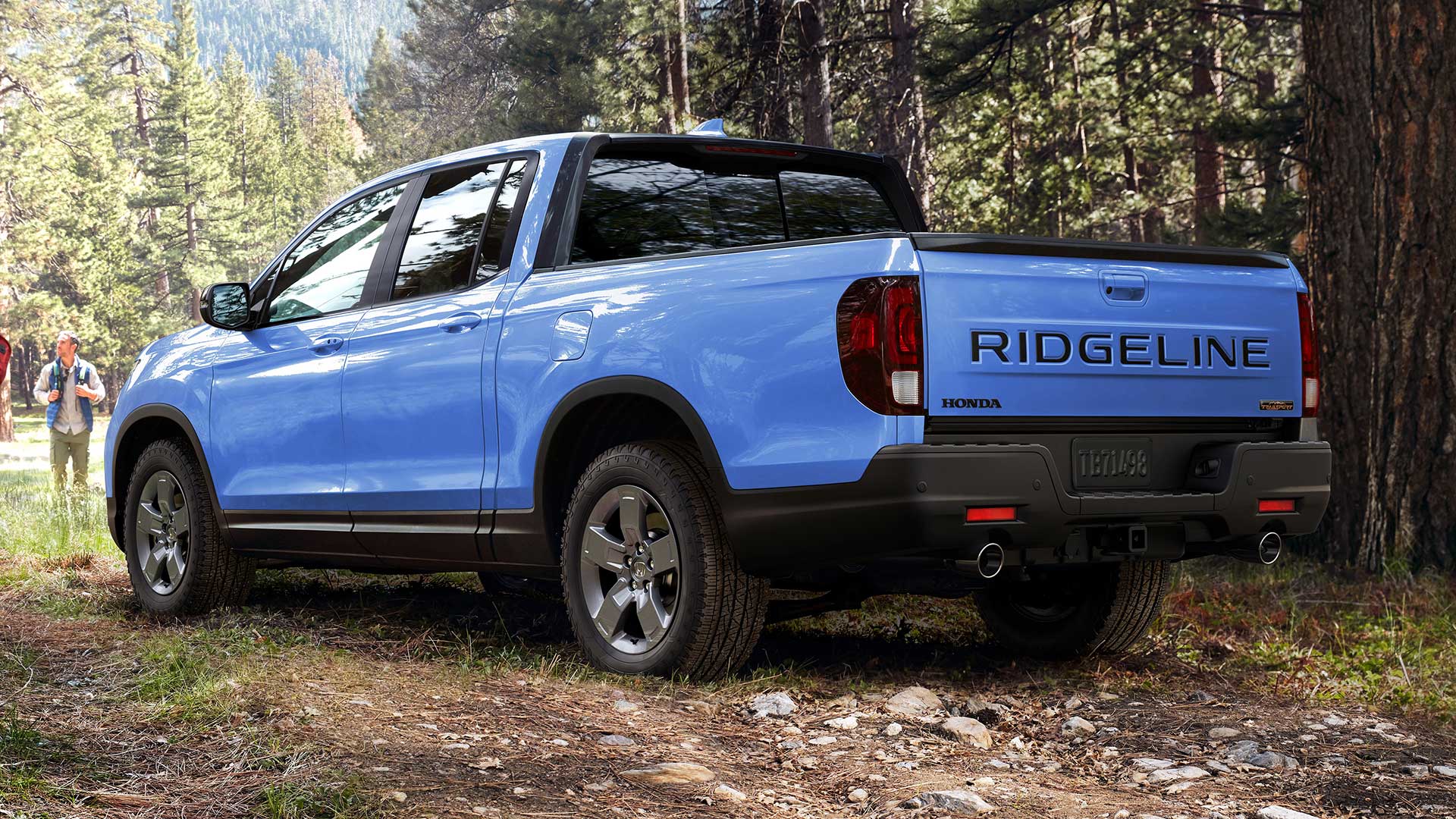2011 Kia Sorento
It’s a clear sign of the times. Kia, responding to current market tastes, has redesigned their compact Sorento without its original body-on-frame SUV chassis, opting instead for a crossover utility unibody. Now Kia hopes this move will greatly expand the Sorento’s appeal. But does being more like a car, and less like a truck, make for a better Sorento?
Besides its chassis transformation, the second generation 2011 Kia Sorento is also the Korean brand’s first vehicle to have its assembly transferred to American soil. That takes place at a huge new facility in West Point, Georgia.
Still, Sorento enters an already crowded compact CUV segment, and faces stiff competition from other quality entrants like the Toyota RAV4, Nissan Rogue, and also new Chevrolet Equinox. Like the Equinox, the Sorento is called a compact, but it’s nearly mid-size both outside and inside. Using a chassis shared with the Hyundai Santa Fe, Sorento’s length of 183.9 inches is over three inches longer than before, if slightly lower for better aerodynamics.
The totally refashioned exterior echoes Kia’s new, bolder, front-end theme begun with the Forte. The grill and flared-back headlights form a continuous arch that is most appealing.
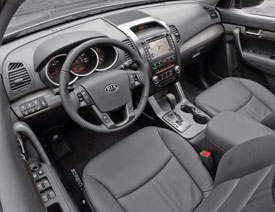 Based on the KND-4 concept from the 2007 Los Angeles Auto Show, the production Sorento has a similar sweeping profile and athletic stance. Roof rails are optional. The rounded rear-end also exudes lots of presence, with large LED taillights that extend into the liftgate. Wheels are 17 and 18-inch alloys, with a mirror finish optional on top EX trim.
Based on the KND-4 concept from the 2007 Los Angeles Auto Show, the production Sorento has a similar sweeping profile and athletic stance. Roof rails are optional. The rounded rear-end also exudes lots of presence, with large LED taillights that extend into the liftgate. Wheels are 17 and 18-inch alloys, with a mirror finish optional on top EX trim.
While the original Sorento offered a pair of V6s, the 2011 allows a more varied choice. Standard is a 2.4-liter inline-4 shared with the Forte SX. Output is 175 horsepower and 169 pound-feet of torque.
Optional is an all-new 3.5-liter V6 with a best-in-class 276 horsepower and 248 pound-feet of torque. But even with it, trailer towing takes a beating: 3,500 pounds, down from 5,000 last year.
A six speed manual is standard with the I-4. Kia’s first home-grown six-speed automatic is an option, and standard with the V-6. A single speed four-wheel drive system with locking center differential can be fitted to either engine. And, even with front drive, useful Hill Start Assist and Downhill Brake Assist are included.
Government Fuel Economy Ratings for our front-drive four-cylinder automatic are good at 21 city/29 highway on regular gas. We saw a respectable 24.3 miles per gallon in real world driving. But, you do pay for that efficiency on the track. Our I-4 Sorento huffed from 0 to 60 in a long 10.1 seconds. And the quarter mile dragged out to 17.7 seconds at 78 miles per hour. The Sorento felt breathless all the way down the track. Shifts were lazy and power-robbing.
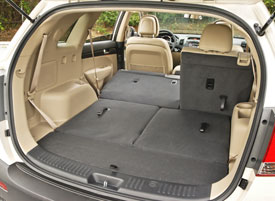 The Sorento’s new unibody employs a MacPherson strut front, and multilink rear suspensions. Electronic Stability Control is standard.
The Sorento’s new unibody employs a MacPherson strut front, and multilink rear suspensions. Electronic Stability Control is standard.
Unfortunately, none of this helped inspire a high level of confidence in our handling tests. Steering was quick enough but with little feedback, and body roll was excessive.
The one bright spot in Sorento’s track performance was braking. The all-disc, ABS brakes delivered arrow-straight, near fade-free stops of a short 120 feet on average from 60 to 0. The pedal was firm with positive feedback.
On normal roads, the Sorento is a lot more self-assured. It’s comfortable and quiet, feeling well anchored at even elevated interstate speeds.
That comfort continues inside, where Kia used the extra body length for more cabin space and versatility. With both five- and first time three-row seven-passenger models, it’s now a big family-mover. The modern, tech-inspired dash is defined by overlapping gauges and practical controls. Our EX model’s well-padded seats came with standard eight-way power for the driver, and optional heat.
Standards include a tilt/telescoping wheel with audio and Bluetooth controls. Satellite Radio and a USB port are on board too. A 550-watt Infinity upgrade, navigation, and even a dual sunroof, are available. Our EX added push button start, and a backup camera with rear view mirror display.
Those in the 60/40 second row will find it quite roomy, with a welcomed increase in legroom. Kids will like the 50/50 split folding third row, but not adults. Behind the third row is 9.1 cubic feet of space that expands to 37 cubic feet when folded, and an excellent 72.5 with all seats down. A reversible load floor and handy underfloor compartment add to this CUV’s overall practicality.
And that practicality also speaks to Kia’s value pricing. In fact, the base price for the 2011 Sorento is down from last year starting at $20,790. Sorento base prices top out at $29,690.
Combine that with Kia’s vastly improved quality reputation, and one of the best warranties going, and it’s no wonder they continue to chalk up sales gains. The new Sorento’s track performance may be lacking, but we have no qualms with its packaging. So, the 2011 Kia Sorento is indeed a better answer to what today’s family buyers want. And, yes, it’s a better Sorento, too.
Specifications
- Engine: 2.4-Liter Inline-4
- Horsepower: 175
- Torque: 169 Lb Feet
- 0-60 MPH: 10.1 Seconds
- 1/4 Mile: 17.7 Seconds @ 78 MPH
- 60-0 MPH: 120 Feet
- EPA: 21 MPG City/ 29 MPG Highway
- Mixed Loop: 24.3 MPG
2024 Honda Ridgeline TrailSport
It Does Truck-Like Things Better Than Ever
Honda brought something truly unique to the pickup truck scene when their mid-size Ridgeline debuted for 2006. In 2017, it moved towards becoming a little more true truck-like, both in form and capability, now with yet another step in that direction for 2024. So, let’s see if the Ridgeline is really hitting its stride.
For 2024, it’s all about making this Honda Ridgeline better than ever. There are styling tweaks outside, along with tech and functional improvements inside, but the biggest news is the Ridgeline has now joined Honda’s TrailSport family of off-road inspired vehicles. This more-true-trucklike, second-gen Ridgeline been around since 2017, receiving periodic updates over the years; but joining the TrailSport family is the biggest leap yet.
Primarily, the TrailSport transformation includes General Grabber all-terrain tires, mounted on new Pewter Gray 18-inch wheels, steel underbody protection, and retuning the strut front, and multi-link rear suspension for added wheel articulation. And while we always appreciate the additional traction of off-road tires, the Ridgeline’s standard i-VTM4 all-wheel drive, with Intelligent Traction Management and snow, sand, and mud settings, was already quite capable of handling all but the most extreme off-roading, ground clearance of just 7.6 inches being it’s only real hinderance.
A 3.5-liter V6 remains under the hood as it has since the Ridgeline debuted for 2006; the current version outputs 280 horsepower and 262 lb-ft of torque, plenty enough muscle to handle its 5,000-lbs. towing capacity. A nine-speed automatic transmission with paddle shifters and bevy of push and pull buttons on the console replaced the six-speed automatic back in 2020.
In addition to adding TrailSport capability, a big focus for this update was making it more user-friendly inside, starting with the central touchscreen growing from 8 to 9 inches. It also gets faster processing speeds, menus have been simplified, and the native navigation system is improved with better graphics. It’s accompanied by a new digital instrument cluster, along with an upgraded center console with more storage space. Unique TrailSport touches include heavy duty floormats, leather-trimmed seats, orange stitching throughout the cabin, and orange ambient lighting.
The Ridgeline continues to offer things available nowhere else in the pickup truck market.
Exterior styling doesn’t exactly shout “macho big rig coming your way,” but the more vertical face and larger grille that arrived for 2021, along with this year’s added TrailSport elements, do continue to toughen up the Ridgeline’s image. The 5’4” bed remains highly functional with no large wheel well intrusions, multiple tie-downs points, lighting and even speakers. And of course, the Ridgeline continues to offer things available nowhere else in the pickup truck market, like the dual-action tailgate, and large, lockable, drainable, underbed storage. Not to mention being able to drive around in true car-like comfort, something we took full advantage of on our way to our Mason Dixon Dragway test track.
There was great grip off the line, with full power arriving smoothly but quickly, helping us to get to 60 in 7.0 seconds flat, a tenth quicker than the last Ridgeline we tested. That power delivery stayed fairly consistent the whole way down the track, barely interrupted by the nine-speed automatic’s smooth shifting. Our best quarter-mile run was 15.5 seconds at 90 mph.
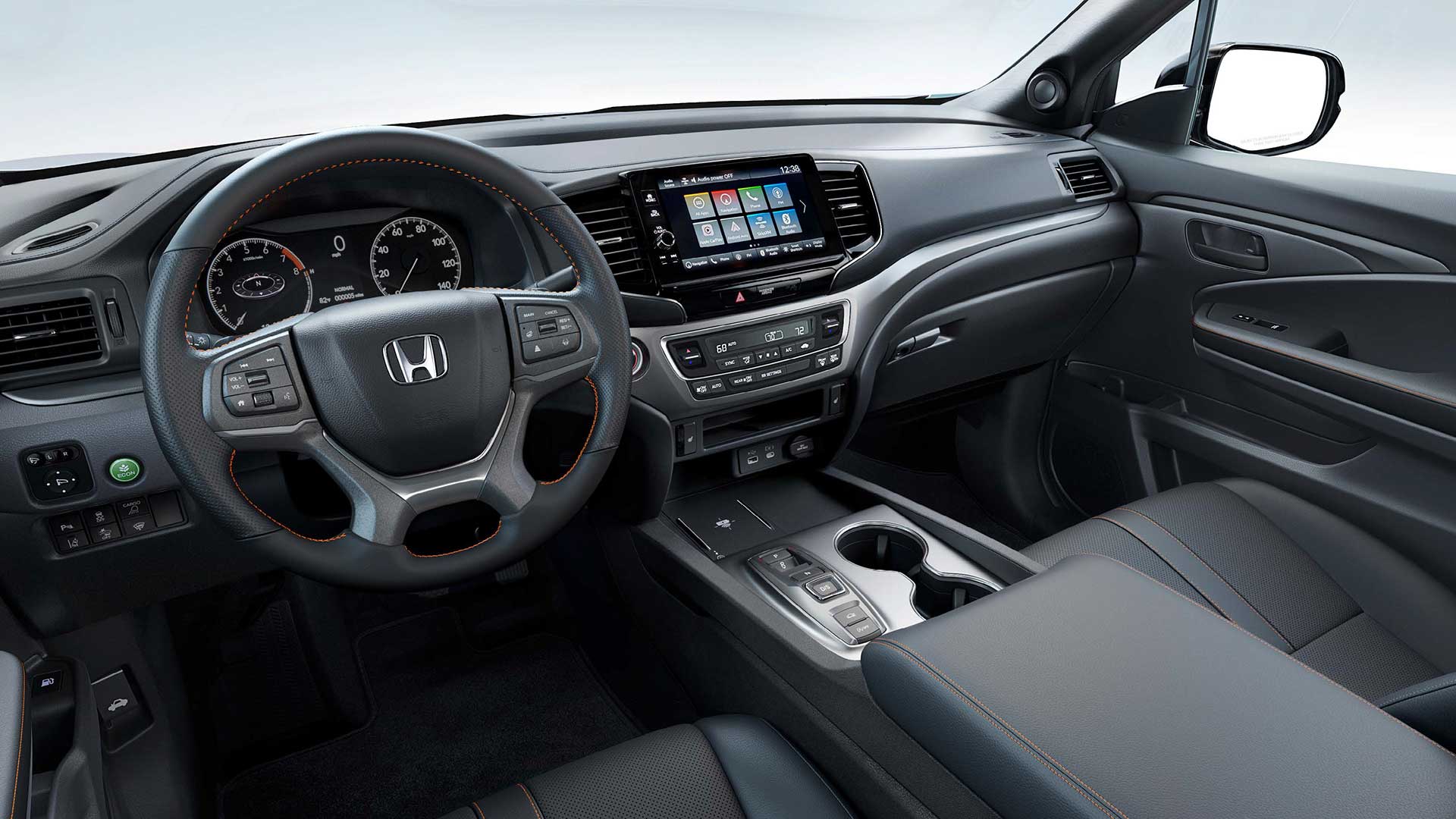
The revised suspension and knobbier tires didn’t really seem to add or detract from handling prowess, as it felt as solid, nimble, and car-like as it always has through our cone course. Perhaps a little less stiff than before, but good feedback, tight steering, and minimal body roll for a pickup, made for a very confidence inspiring experience. In our braking test, we stopped in a respectable average of 123 feet from 60, with only moderate amounts of nosedive and good feel through the pedal.
There is, however, a slight reduction in Government Fuel Economy Ratings with the all-terrain tires; 18-City, 23-Highway, and 20-Combined, our average, right on, at 20.4 mpg of Regular. That’s a slightly below average Energy Impact Score of 14.9 barrels of yearly oil use, with CO2 emissions of 7.4 tons.
TrailSport pricing falls in line just under the Ridgeline’s top Black Edition trim with a starting price of $46,375, about five grand over a base Ridgeline Sport.
So, whether you consider the Honda Ridgeline to be a “real” truck or not, this ruggedly smooth 2024 TrailSport does truck-like things better than ever. And we’re not just talking about the slight upgrade in off-road performance, we’re talking about a flexible bed to help you get chores done, and the ability to tow or haul with comfort and flexibility other trucks can only wish for. It’s why the Ridgeline brings more first-time buyers to Honda than any other vehicle, and why it continues to be a great choice in the growing midsize truck realm.
Specifications
- Engine: 3.5-liter V6
- Transmission: 9-speed automatic
- Horsepower: 280
- Torque: 262 lb-ft
- EPA: 18 City | 23 Highway | 20 Combined
- 0-60 mph: 7.0 seconds
- 1/4 Mile: 15.5 seconds at 90 mph
- 60-0 Braking (avg): 123 feet
- MW Fuel Economy: 20.4 mpg (Regular)
- Max Towing Capacity: 5,000-lbs








